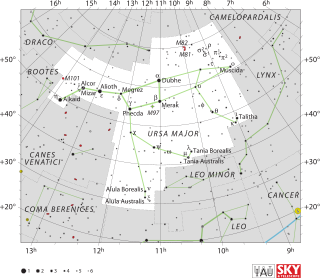astro.wikisort.org - Star
Nu Ursae Majoris (ν Ursae Majoris, abbreviated Nu UMa, ν UMa), formally named Alula Borealis /əˈluːlə bɒriˈælɪs/,[8][9] is a double star in the northern circumpolar constellation of Ursa Major. At an apparent visual magnitude of +3.490,[2] it is bright enough to be seen with the naked eye. Based upon parallax measurements, the distance to ν Ursae Majoris is about 399 light-years (122 parsecs).[1]
 Location of ν Ursae Majoris (circled) | |
| Observation data Epoch J2000.0 Equinox J2000.0 (ICRS) | |
|---|---|
| Constellation | Ursa Major |
| Right ascension | 11h 18m 28.73664s[1] |
| Declination | +33° 05′ 39.5107″[1] |
| Apparent magnitude (V) | +3.490[2] |
| Characteristics | |
| Spectral type | K3 III[3] |
| U−B color index | +1.550[2] |
| B−V color index | +1.400[2] |
| Astrometry | |
| Radial velocity (Rv) | -9.63 ± 0.38[4] km/s |
| Proper motion (μ) | RA: –26.84[1] mas/yr Dec.: +28.69[1] mas/yr |
| Parallax (π) | 8.17 ± 0.17 mas[1] |
| Distance | 399 ± 8 ly (122 ± 3 pc) |
| Absolute magnitude (MV) | −2.47 ± 0.16[5] |
| Details | |
| Radius | 57.07 ± 4.13[5] R☉ |
| Luminosity | 775 ± 122[5] L☉ |
| Surface gravity (log g) | 1.89[5] cgs |
| Temperature | 4,070[5] K |
| Metallicity [Fe/H] | –0.04[5] dex |
| Rotational velocity (v sin i) | 10[6] km/s |
| Other designations | |
| Database references | |
| SIMBAD | data |
This is a giant star with a stellar classification of K3 III.[3] It has expanded to about 57 times the radius of the Sun and is radiating 775 times the Sun's luminosity.[5] The effective temperature of the outer envelope is 4,070 K;[5] cool enough to give it an orange hue typical of a K-type star.[10] It has a 10th-magnitude optical companion at an angular separation of 7.1 arcseconds.
Nomenclature
ν Ursae Majoris (Latinised to Nu Ursae Majoris) is the star's Bayer designation.
It also bore the traditional name of Alula Borealis.[11] Alula (shared with Xi Ursae Majoris) comes from the Arabic phrase Al Ḳafzah al Ūla 'the First Spring'.[12] and Borealis is Latin for 'northern'. In 2016, the International Astronomical Union organized a Working Group on Star Names (WGSN)[13] to catalog and standardize proper names for stars. The WGSN's first bulletin of July 2016[14] included a table of the first two batches of names approved by the WGSN; which included Alula Borealis for this star.
In Chinese, 三台 (Sān Tái), meaning Three Steps, refers to an asterism consisting of Nu Ursae Majoris, Iota Ursae Majoris, Kappa Ursae Majoris, Lambda Ursae Majoris, Mu Ursae Majoris, and Xi Ursae Majoris. Consequently, the Chinese name for Nu Ursae Majoris itself is 下台一 (Xià Tái yī, English: Star of First Lower Step).[15]
References
- van Leeuwen, F. (November 2007), "Validation of the new Hipparcos reduction", Astronomy and Astrophysics, 474 (2): 653–664, arXiv:0708.1752, Bibcode:2007A&A...474..653V, doi:10.1051/0004-6361:20078357, S2CID 18759600
- Jennens, P. A.; Helfer, H. L. (September 1975), "A new photometric metal abundance and luminosity calibration for field G and K giants.", Monthly Notices of the Royal Astronomical Society, 172 (3): 667–679, Bibcode:1975MNRAS.172..667J, doi:10.1093/mnras/172.3.667
- Morgan, W. W.; Keenan, P. C. (1973), "Spectral Classification", Annual Review of Astronomy and Astrophysics, 11: 29–50, Bibcode:1973ARA&A..11...29M, doi:10.1146/annurev.aa.11.090173.000333
- Famaey, B.; et al. (January 2005), "Local kinematics of K and M giants from CORAVEL/Hipparcos/Tycho-2 data. Revisiting the concept of superclusters", Astronomy and Astrophysics, 430: 165–186, arXiv:astro-ph/0409579, Bibcode:2005A&A...430..165F, doi:10.1051/0004-6361:20041272, S2CID 17804304
- Piau, L.; et al. (February 2011), "Surface convection and red-giant radius measurements", Astronomy and Astrophysics, 526: A100, arXiv:1010.3649, Bibcode:2011A&A...526A.100P, doi:10.1051/0004-6361/201014442, S2CID 118533297
- Bernacca, P. L.; Perinotto, M. (1970), "A catalogue of stellar rotational velocities", Contributi Osservatorio Astronomico di Padova in Asiago, 239 (1), Bibcode:1970CoAsi.239....1B
- "54 UMa -- Star in double system", SIMBAD, Centre de Données astronomiques de Strasbourg, retrieved 2012-01-11
- Kunitzsch, Paul; Smart, Tim (2006). A Dictionary of Modern star Names: A Short Guide to 254 Star Names and Their Derivations (2nd rev. ed.). Cambridge, Massachusetts: Sky Pub. ISBN 978-1-931559-44-7.
- "IAU Catalog of Star Names". Retrieved 28 July 2016.
- "The Colour of Stars", Australia Telescope, Outreach and Education, Commonwealth Scientific and Industrial Research Organisation, December 21, 2004, archived from the original on December 3, 2013, retrieved 2012-01-16
- Piazzi, G., The Palermo Catalogue, Palermo, 1814.
- Richard Hinckley Allen :Star Names — Their Lore and Meaning - Ursa Major, the Greater Bear
- "IAU Working Group on Star Names (WGSN)". Retrieved 22 May 2016.
- "Bulletin of the IAU Working Group on Star Names, No. 1" (PDF). Retrieved 28 July 2016.
- (in Chinese) (Activities of Exhibition and Education in Astronomy) 天文教育資訊網 2006 年 6 月 21 日
На других языках
[de] Ny Ursae Majoris
Ny Ursae Majoris (kurz ν UMa) ist ein Doppelstern im Sternbild Großer Bär. Der Zentralstern ist ein Riese der Spektralklasse K3 und besitzt eine scheinbare Helligkeit von 3,5 mag. Das System ist rund 400 Lichtjahre von der Sonne entfernt. Der Winkelabstand des Begleiters beträgt rund 7 Bogensekunden.- [en] Nu Ursae Majoris
[es] Alula Borealis
Alula Borealis (ν Ursae Majoris / ν UMa / 54 Ursae Majoris) es una estrella en la constelación de la Osa Mayor de magnitud aparente +3,49. La palabra Alula proviene de una frase árabe que significa «el primer salto», mientras que la palabra Borealis hace referencia a su posición al norte respecto a Alula Australis (ξ Ursae Majoris). Esta estrella es medianamente fácil de divisar al límite del norte desde el hemisferio sur en el mes de abril.[ru] Алула Северная
Ню Большой Медведицы (ν UMa / ν Ursae Majoris / ν Большой Медведицы) — является двойной звездой в созвездии Большая Медведица. Звезда имеет традиционное название Алула (иногда Алюла) Северная (Алула Бореалис, «Первая северная»).Другой контент может иметь иную лицензию. Перед использованием материалов сайта WikiSort.org внимательно изучите правила лицензирования конкретных элементов наполнения сайта.
WikiSort.org - проект по пересортировке и дополнению контента Википедии